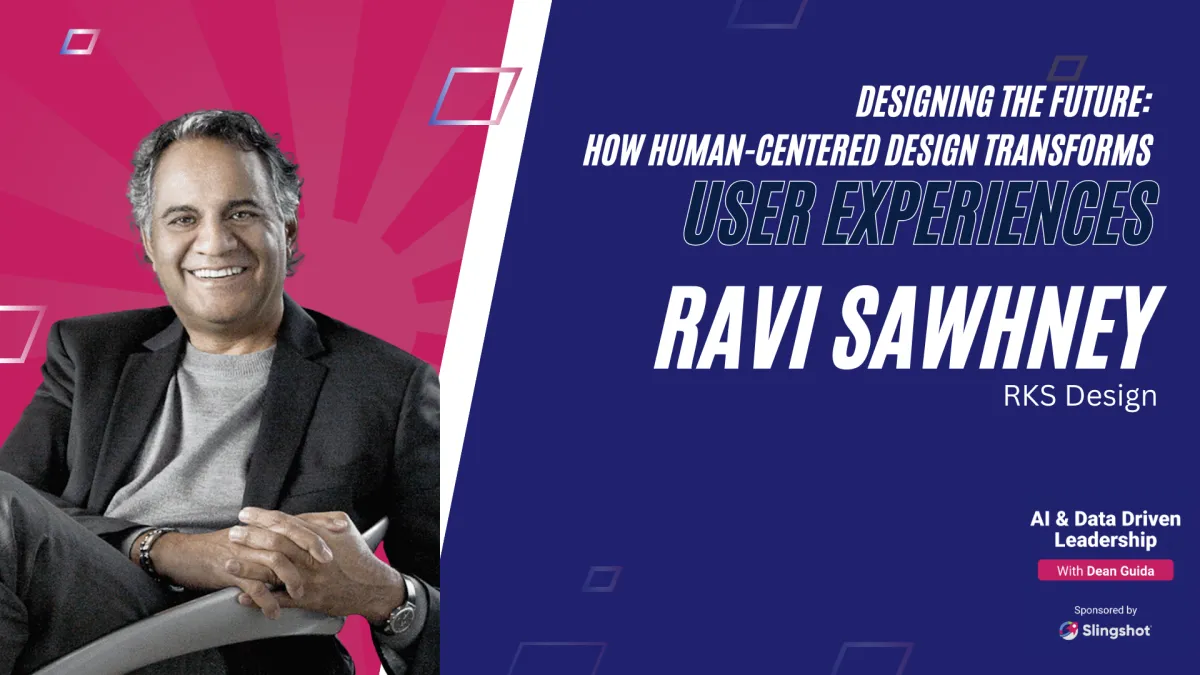Blog

16 - Designing the Future: How Human-Centered Design Transforms User Experiences
Human-Centered Design and Psycho Aesthetics: Insights from Ravi Sawhney
In the latest episode of the AI & Data Driven Leadership Podcast, Dean Guida sits down with Ravi Sawhney, CEO and Founder of RKS Design. Ravi shares his transformative insights into human-centered design and introduces his innovative methodology, psycho aesthetics. This episode dives into the power of understanding human emotions in the design process and how design thinking can drive meaningful change in both product development and user experiences.
The Core of Human-Centered Design
Human-centered design is all about creating solutions that truly meet the needs of users by considering their behaviors, feelings, and experiences. It’s a holistic approach that ensures products aren’t just functional, but resonate emotionally with their users.
Empathy plays a key role in this process—designers need to understand the user’s world, challenges, and desires to create products that feel natural and intuitive. By ideating, prototyping, and testing, designers can refine their concepts to ensure they’re not only useful but deeply meaningful.
Introducing Psycho Aesthetics: A New Design Framework
Ravi Sawhney’s psycho aesthetics methodology combines the best of human-centered design with psychological and emotional insights. Since its development in 1992, this framework has helped shape countless innovative products, from toys to medical devices. At its core, psycho aesthetics uses tools like personas, user journeys, and competitive benchmarking to design experiences that connect with users on a deeper, more emotional level.
A particularly unique aspect of this methodology is its incorporation of the Hero’s Journey, a concept borrowed from storytelling. By understanding the emotional journey users go through, designers can craft products that not only solve problems but also empower users and create lasting emotional connections.
Design Thinking for Empowerment
In Ravi’s approach, designing for empowerment is a crucial step. He emphasizes the importance of creating products that make users feel good about their choices, contributing to higher engagement and adoption rates. When users feel empowered by the products they use, they are more likely to champion those products to others.
Through thoughtful design, we can build products that do more than just function—they can create a sense of belonging, self-affirmation, and emotional connection with the user. This is particularly important when designing for industries like healthcare, where emotional resonance can significantly impact user satisfaction and adoption.
AI in Design: Enhancing Human-Centered Solutions
While AI is often seen as a tool for automation and efficiency, Ravi reveals how his team uses AI to gather data-driven insights that inform their design process. However, he emphasizes that AI should not replace human intuition but rather complement it. Human interaction and ethnographic research remain essential to understanding the true emotional and cognitive needs of users.
By combining AI with deep human insights, designers can make informed decisions that enhance the emotional connection users feel toward a product, ensuring that the final design is both innovative and deeply human.
Episode Highlights
Human-Centered Design: A holistic approach to creating emotionally resonant products that meet real user needs.
Psycho Aesthetics: Ravi Sawhney’s unique framework that combines psychological principles with design thinking.
The Hero’s Journey in Design: Leveraging storytelling principles to enhance user engagement and create emotionally impactful products.
Design for Empowerment: How empowering users can drive product adoption and build emotional loyalty.
AI and Design: How AI can complement human insights in the design process to create better, more effective products.
This episode underscores the power of human-centered design and the role of emotional connections in product development. Ravi Sawhney’s approach offers valuable insights into how we can use design not just to solve problems but to truly resonate with users, empowering them to engage with products on a deeper level.
Want to Learn More?
Explore Slingshot.io: Discover how Slingshot.io uses AI and data-driven insights to support businesses in their growth journey.
Apply to be a Podcast Guest: If you’re a leader in AI, design, or technology and want to share your insights, apply to be a guest on our podcast by clicking here.
By embracing human-centered design and leveraging methodologies like psycho aesthetics, designers and leaders can create products that not only solve problems but also foster real emotional connections with users.
🎧 Listen to the full episode here
Listen and Subscribe to the AI & Data Driven Leadership Podcast Now:
Say "Hey, Siri / Alexa. Play AI & Data Driven Leadership Podcast"
About The Host
Tech entrepreneur and CEO Dean Guida knows there’s a limit to what you can build with grit alone.
At sixteen, Dean bought the first IBM PC and fell in love with writing software. He went on to receive a Bachelor of Science degree in operation research from the University of Miami. After graduating, he was a freelance developer and wrote many systems for IBM and on Wall Street. At twenty-three, he started Infragistics to build UX/UI tools for professional software developers.
Seemingly overnight, Dean had to go from early internet coder to business operator—a feat that forced him to learn some of business’s biggest lessons on the job. He immediately began navigating the nuances of scaling a company, hiring and growing teams, and becoming a leader, a manager, and a mentor.
Fast-forward thirty-five years, and Dean’s tech company now has operations in six countries. More than two million developers use Infragistics software, and its client roster boasts 100 percent of the S&P 500, including Fidelity, Morgan Stanley, Exxon, Intuit, and Bank of America.

Media














